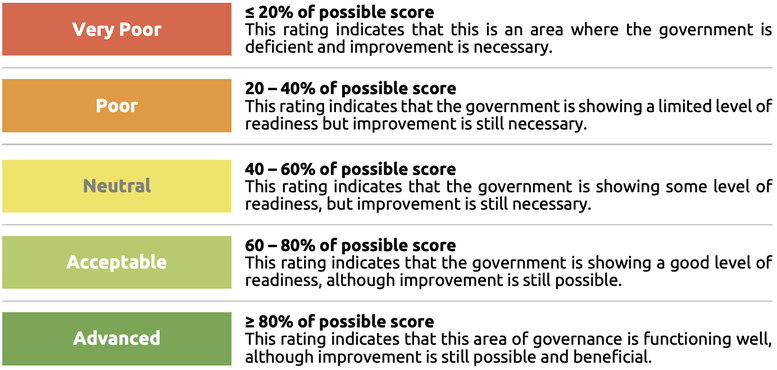Climate Governance in Kenya (2019 Assessement)
Attachments

The CAT Climate Governance series seeks to produce a practical framework for assessing a government’s readiness - both from an institutional and governance point of view - to ratchet up climate policy and implement adequate transformational policies on the ground, to enable the required economy-wide transformation towards a zero emissions society.

Our methodology
We have set up a framework that assesses and scores a number of indicators, where we rate various aspects of governance. This allows us to establish a common basis on which to compare climate governance across countries as well as identify areas of improvement and highlight positive developments. We have applied this framework at both a national level and on key emissions-intensive sectors of the economy. In Kenya's case we have focused on the agriculture and forestry sector.
For the purpose and overview of this series, see our Climate Governance series main page. The methodology framework used for this Kenya assessment is here. For more detail on our methodology, see here: methodology page.
Assessment of national level readiness
Kenya’s national political commitment towards climate change mitigation issues is evident; however, there is room for improvement. Leadership from the head of state and leading institutions can take a more aggressive stance on scaling up climate action domestically. Greater autonomy and power for climate-related agencies would further expedite the development and implementation of climate policy.
The institutional framework governing Kenya’s governmental and ministerial processes is more robust in some areas yet could be improved in others. There are concerns over whether the amount of available human and financial resources to manage Kenya’s current climate processes are sufficient. Coordination at the ministerial level exists; however, a clear framework for policy alignment is lacking. There is a moderate amount of decarbonisation analyses for consideration in national climate strategies, with limited knowledge generated from outside government agencies.
Much of Kenya’s processes for policy development, implementation and review are either too new to assess or are still under development, although there are positive signs of progress towards establishing them. Kenya’s long-term climate policy planning processes can be improved, as current action plans only cover the medium term, and no quantitative emissions reduction targets have been established.
The Kenyan government has shown a medium to strong approach to stakeholder engagement. There are structures in place to consider non-state interests and perspectives on climate issues and evidence that consultations have taken place. However, the government could demonstrate greater transparency and consistency in addressing and integrating those interests.
Rating system

We analyse ten different criteria of governance under four categories that cover the key enabling factors for effective climate action. We give each a rating as outlined above (poor - neutral - advanced). The methodology framework used for this Kenya assessment is here. For more detail on our methodology in general, click the link below.
Ratings and Recommendations
The following section outlines the results of the analysis for each of the different categories and criteria as well as our recommendations for each category of governance.

- Strengthen the political commitment on climate mitigation at the highest levels of government and raise the profile of climate mitigation by including it in the Big Four Agenda, Vision 2030 or similar plans.
- Strengthen the Climate Change Directorate’s coordination role for climate action among ministries.

- Ensure that all ministries meet the obligations set out in the Climate Change Act (e.g. assign a senior officer as climate change focal point) and that sectoral policies are in line with national climate target (NDC).

- Include a 1.5°C compatible long-term emissions reduction target into the Climate Change Act and develop action plans to reach this target.
- Establish a ratchet-up mechanism to ensure further policies are adopted if the country is not on track to meet its target or to strengthen targets if more ambitious action is needed.

- Ensure that Kenya integrates non-state actor interests in policy processes and addresses negative externalities caused in the transition to a zero emissions society.
Kenya's Climate Governance
These tables from the report give an overview and analysis of the key factors of Kenya's governance to enable effective climate action. We look at the country's key institutions, strategies, targets and legislation, as well at a sectoral level for Kenya's electricity supply.




Assessment of sectoral level readiness
The report also assesses the readiness of Kenya's electricity sector. See the report for details.
A more recent version of our climate governance assessment for Kenya is available here.
Quick links
This report on Kenya is part of the CAT Climate Governance series where we look at the governance models of a number of countries. You can use the links below to find the assessments of the other countries as well as information about the series itself and details on how the assessments were carried out.
Stay informed
Subscribe to our newsletter
 Climate Governance in Argentina
Climate Governance in Argentina
 Climate Governance in Australia
Climate Governance in Australia
 Climate Governance in Ethiopia
Climate Governance in Ethiopia
 Climate Governance in Ghana
Climate Governance in Ghana
 Climate Governance in Indonesia
Climate Governance in Indonesia
 Climate Governance in Kenya
Climate Governance in Kenya
 Climate Governance in the Philippines
Climate Governance in the Philippines
 Climate Governance in South Africa
Climate Governance in South Africa